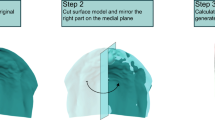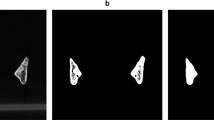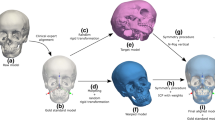Abstract
Objectives
The aim of this study was to develop an accurate and intuitive semi-automatic segmentation technique to calculate an average maxillary arch and palatal growth profile for healthy newborns in their first year of life.
Materials and methods
Seventy babies born between 1985 and 1988 were included in this study. Each child had five impressions made in the first year after birth that were digitalized. A semi-automatic segmentation tool was developed and used to assess the maxillary dimensions. Finally, random effect models were built to describe the growth and build a simulation population of 10,000 newborns. The segmentation was tested for inter- and intra-observer variability.
Results
The Pearson correlation coefficient for each of the variables was between 0.94 and 1.00, indicating high inter-observer agreement. The paired sample t test showed that, except for the tuberosity distance, there were small, but significant differences in the landmark placements between observers. Intra-observer repeatability was high, with Pearson correlation coefficients ranging from 0.87 to 1.00 for all measurements, and the mean differences were not significant. A third or second degree growth curve could be successfully made for each parameter.
Conclusions
These findings indicated this method could be used for objective clinical evaluation of maxillary growth.
Clinical relevance
The resulting growth models can be used for growth studies in healthy newborns and for growth and treatment outcome studies in children with cleft lip and palate or other craniofacial anomalies.



Similar content being viewed by others
References
Bishara SE, Ortho D, Jakobsen JR, Treder J, Nowak A (1997) Arch width changes from 6 weeks to 45 years of age. Am J Orthod Dentofac Orthop 111:401–409. https://doi.org/10.1016/S0889-5406(97)80022-4
Hermann NV, Jensen BL, Dahl E, Darvann TA, Kreiborg S (2001) A method for three-projection infant cephalometry. Cleft Palate-Craniofacial J 38:299–316. https://doi.org/10.1597/1545-1569(2001)038<0299:AMFTPI>2.0.CO;2
Heidbuchel KLWM, Kuijpers-Jagtman AM, Van’t Hof MA et al (1998) Effects of early treatment on maxillary arch development in BCLP. A study on dental casts between 0 and 4 years of age. J Cranio-Maxillo-Facial Surg 26:140–147. https://doi.org/10.1016/S1010-5182(98)80003-6
Sillman JH (1964) Dimensional changes of the dental arches: longitudinal study from birth to 25 years. Am J Orthod 50:824–842. https://doi.org/10.1016/0002-9416(64)90040-5
Felix-Schollaart B, Hoeksma JB, Prahl-Andersen B (1992) Growth comparison between children with cleft lip and/or palate and controls. Cleft Palate-Craniofacial J 29:475–480. https://doi.org/10.1597/1545-1569(1992)029<0475:GCBCWC>2.3.CO;2
Kramer GJC, Hoeksma JB, Prahl-Andersen B (1994) Palatal changes after lip surgery in different types of cleft lip and palate. Cleft Palate-Craniofacial J 31:376–384. https://doi.org/10.1597/1545-1569(1994)031<0376:PCALSI>2.3.CO;2
Sillman JH (1951) Serial study of good occlusion from birth to 12 years of age. Am J Orthod 37:481–507. https://doi.org/10.1016/0002-9416(51)90070-X
Seckel NG, Van der Tweel I, Elema GA, Specken TFJMC (1995) Landmark positioning on maxilla of cleft lip and palate infant - a reality? Cleft Palate-Craniofacial J 32:434–441
Clark SA, Atack NE, Ewings P, Hathorn IS, Mercer NSG (2007) Early surgical outcomes in 5-year-old patients with repaired unilateral cleft lip and palate. Cleft Palate-Craniofacial J 44:235–238. https://doi.org/10.1597/06-044
Nur RB, Cakan DG, Noyan A (2016) Evaluation of oxygen saturation and heart rate during intraoral impression taking in infants with cleft lip and palate. J Craniofac Surg 27:e118–e121. https://doi.org/10.1097/SCS.0000000000002365
American Cleft Palate-Craniofacial Association (2018) Parameters for evaluation and treatment of patients with cleft lip/palate or other craniofacial differences. Cleft Palate-Craniofacial J 55:137–156. https://doi.org/10.1177/1055665617739564
Braumann B, Keilig L, Bourauel C, Jäger A (2002) Three-dimensional analysis of morphological changes in the maxilla of patients with cleft lip and palate. Cleft Palate-Craniofacial J 39:1–11. https://doi.org/10.1597/1545-1569(2002)039<0001:TDAOMC>2.0.CO;2
World Health Organization. Nutrition for Health and Development (2009) WHO child growth standards : growth velocity based on weight, length and head circumference: methods and development. Switzerland, Geneva
Hohoff A, Stamm T, Meyer U, Wiechmann D, Ehmer U (2006) Objective growth monitoring of the maxilla in full term infants. Arch Oral Biol 51:222–235. https://doi.org/10.1016/j.archoralbio.2005.07.007
Klingel D, Hohoff A, Kwiecien R, Wiechmann D, Stamm T (2017) Growth of the hard palate in infants with down syndrome compared with healthy infants—a retrospective case control study. PLoS One 12:1–10. https://doi.org/10.1371/journal.pone.0182728
Antoun JS, Cameron C, Hoy WS et al (2015) Evidence of secular trends in a collection of historical craniofacial growth studies. Eur J Orthod 37:60–66. https://doi.org/10.1093/ejo/cju007
Warren JJ, Bishara SE (2001) Comparison of dental arch measurements in the primary dentition between contemporary and historic samples. Am J Orthod Dentofac Orthop 119:211–215. https://doi.org/10.1067/mod.2001.112260
Author information
Authors and Affiliations
Contributions
R. Bruggink contributed to the conception, design, data digitalization, data analysis, interpretation, and drafted and critically revised the manuscript. F. Baan contributed to data analysis and drafted and critically revised the manuscript. G.J.C. Kramer contributed to data acquisition and critically revised the manuscript. E.M. Bronkhorst contributed to statistical analysis and critically revised the manuscript. T.J.J. Maal, A.M. Kuijpers-Jagtman, S.J. Bergé, and E.M. Ongkosuwito contributed to the conception, design, data interpretation and critically revised the manuscript. All authors gave final approval and agree to be accountable for all aspects of the work.
Corresponding author
Ethics declarations
Conflict of interest
The authors declare that they have no conflict of interest.
Ethical approval
The present study was approved by the Research Ethics Committee (CMO), Region Arnhem/Nijmegen, The Netherlands (2016-2654).
All procedures performed in studies involving human participants were in accordance with the ethical standards of the Institutional Review Board and with the 1964 Helsinki declaration and its later amendments or comparable ethical standards.
Informed consent
For this type of study formal consent is not required.
Additional information
Publisher’s Note
Springer Nature remains neutral with regard to jurisdictional claims in published maps and institutional affiliations.
Electronic supplementary material
ESM 1
(DOCX 27 kb)
Rights and permissions
About this article
Cite this article
Bruggink, R., Baan, F., Kramer, G.J.C. et al. Three dimensional maxillary growth modeling in newborns. Clin Oral Invest 23, 3705–3712 (2019). https://doi.org/10.1007/s00784-018-2791-5
Received:
Accepted:
Published:
Issue Date:
DOI: https://doi.org/10.1007/s00784-018-2791-5




